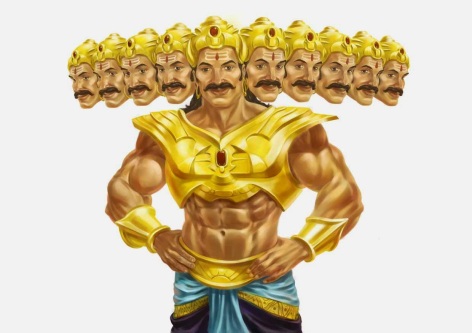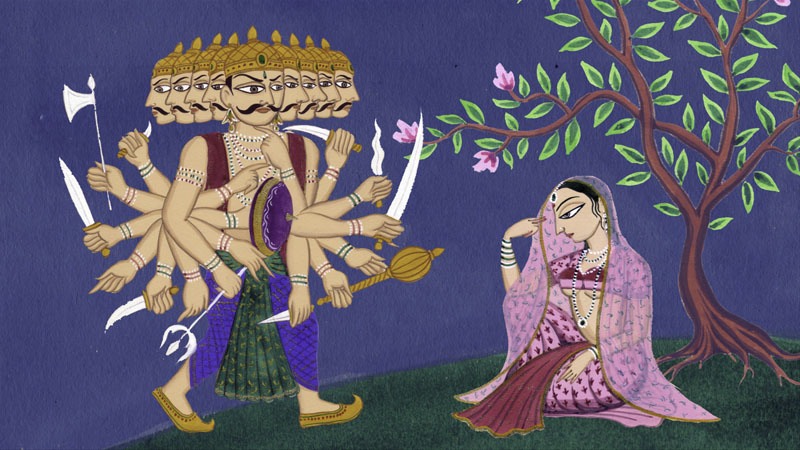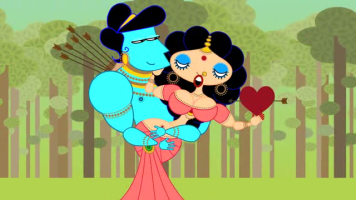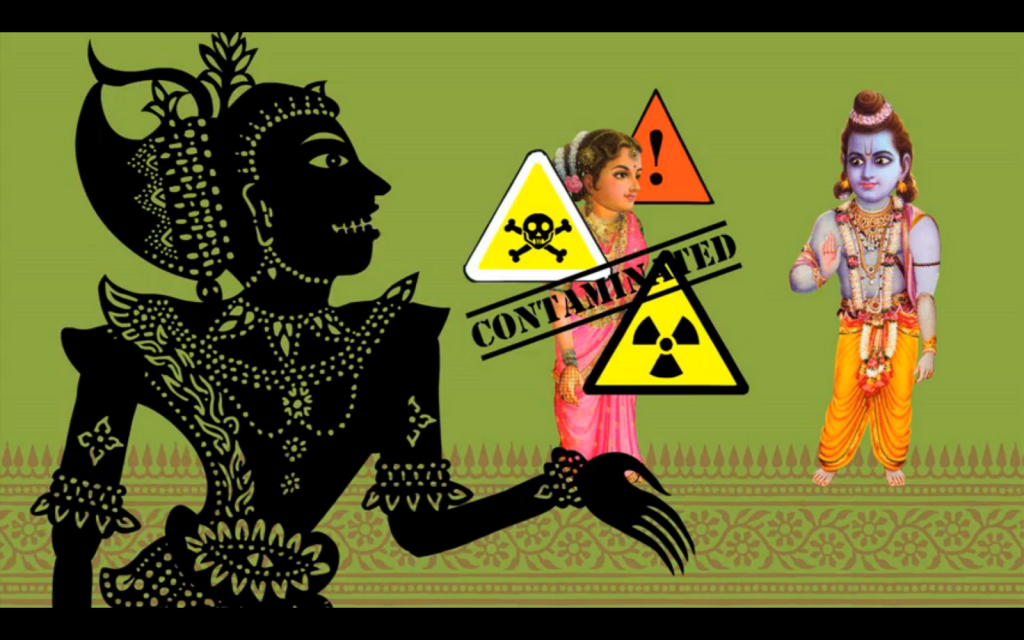 Ramayana remains one of the most popular Indian Mythology ever written in the history of mankind. The brunt of it was so surreal that the majority of them couldn’t demarcate the
Ramayana remains one of the most popular Indian Mythology ever written in the history of mankind. The brunt of it was so surreal that the majority of them couldn’t demarcate the
thin line between history and epic. Most of us grew up in 80s or 90s (or so I presume), one might remember the buffed up Hanuman carrying a miniscule mountain on his palm as he flies through the crummy CGI clouds and glides over spans and spans of jungle on his way. While most of us watched in awe there were several households across the country where people use to sit in front of their television sets with a pooja ki thaali and whenever the protagonist Rama or his ally Hanuman appeared, they’ll start with the ordeal of aarti. Such was the aura of it and it still remains so among the devotional and the God fearing section of the society. As a small child who would hear the stories of Ramayana from his grandmother and watch cartoons and animated movies based on it, I always idolized Lord Rama for rescuing Sita from the evil clutches of Ravana. For me Rama was someone who was gutsy, valiant and devoted who possessed all the qualities of an ideal man whereas Ravana was perceived as a character that was hateful, villainous and destructive which were antonymous to the definition of a perfect man. The portrayal of the two pivotal personalities gave a nationwide perception that since Rama is the perfect illustration of a man with quintessential qualities, one should strive to become more like him and because there is nothing as dreadful and ghastly as the persona of Ravana, one should subject him to abhor and dismiss his traits altogether. Every year since time immemorial through the festivals of Dusshera and Diwali, we celebrate the triumph of good over evil and the effigy of Ravana is set aflame to personify the reason.
But are we dispensing utmost justice?
 The Demon King Ravana known as a meticulous devotee of Lord Shiva and was backed by his people for being an excellent administrator, spunky warrior and a learned patron of music and knowledge. Despite certain loopholes in his attributes like arrogance, negligence and lust for women (read the account of sage Vedavati) , he never attempted to cross the boundaries and touch Sita without her consent. While many could bring the argument that Ravana was cursed so he couldn’t possibly come near Sita with malicious intention, however if that had been his motive, worse outcomes were possible. Despite several turned down proposals, he didn’t harm Sita but ensured that she was provided with all the comforts one could think of.
The Demon King Ravana known as a meticulous devotee of Lord Shiva and was backed by his people for being an excellent administrator, spunky warrior and a learned patron of music and knowledge. Despite certain loopholes in his attributes like arrogance, negligence and lust for women (read the account of sage Vedavati) , he never attempted to cross the boundaries and touch Sita without her consent. While many could bring the argument that Ravana was cursed so he couldn’t possibly come near Sita with malicious intention, however if that had been his motive, worse outcomes were possible. Despite several turned down proposals, he didn’t harm Sita but ensured that she was provided with all the comforts one could think of.
The entire aftermath after the brutal execution of Ravana by the hand of Rama where Sita is eventually rescued but goes through the humiliating ordeal of AgniPariksha just to falsify the absurd suspicion of Rama pertaining to the chastity of her character because she stayed in the abode of Ravana for long enough and thus it might be hard for him to gulp down that Ravana didn’t even touch her. Another imperative incident where even after passing all these tests Sita quietly leaves her husband Lord Rama who is often termed as ‘Maryada Purushottam’ or the ideal man when he asks her to leave him after hearing an ordinary washer man of his kingdom casting doubts on her character. Depicting the patriarchal nature of the Indian society the Valmiki’s Ramayana in one of its verses compares women and the backward castes to animals who are worthy of being beaten to be kept in line. As such the holy text expects the wife to be a paragon of virtue while assigning no reciprocal duties to the husband. The wife in this sense is nothing more than a property at the disposal of her husband. The Ramayana also depicted the love and care of Lord Rama for his wife and the obstacles he willingly faced to save her from the clutches of Ravana but over the years these acts have failed to acquire the status of obligations for a husband and have been reduced to insignificant details of the great text. The religious zeal to guard the aura of infallibility that has developed around Lord Rama has ensured that his actions are never questioned or criticized leaving the Indian women to bear the brunt of the great expectations of the Indian society sanctioned by the Gods. The purpose of this article is neither to eulogize Ravana or castigate Rama but to give the much needed equilibrium and balance out the equations of positive and negative aspects in order to draw a parallel to the present society we live in.
Another imperative incident where even after passing all these tests Sita quietly leaves her husband Lord Rama who is often termed as ‘Maryada Purushottam’ or the ideal man when he asks her to leave him after hearing an ordinary washer man of his kingdom casting doubts on her character. Depicting the patriarchal nature of the Indian society the Valmiki’s Ramayana in one of its verses compares women and the backward castes to animals who are worthy of being beaten to be kept in line. As such the holy text expects the wife to be a paragon of virtue while assigning no reciprocal duties to the husband. The wife in this sense is nothing more than a property at the disposal of her husband. The Ramayana also depicted the love and care of Lord Rama for his wife and the obstacles he willingly faced to save her from the clutches of Ravana but over the years these acts have failed to acquire the status of obligations for a husband and have been reduced to insignificant details of the great text. The religious zeal to guard the aura of infallibility that has developed around Lord Rama has ensured that his actions are never questioned or criticized leaving the Indian women to bear the brunt of the great expectations of the Indian society sanctioned by the Gods. The purpose of this article is neither to eulogize Ravana or castigate Rama but to give the much needed equilibrium and balance out the equations of positive and negative aspects in order to draw a parallel to the present society we live in.
While there are so many different versions and interpretations of Ramayana coupled with umpteen number of modifications and embellishments which make th e scripture complex in nature, the major crux of population knows and widely believes in the most common version which has been depicted in story books and movies and thus people draw their inspiration from the same.The present society where a girl is expected to be a virgin before marriage and her purity determines whether she’ll be accepted by the family stems from a similar school of thought who blindly conform with the virtues of patriarchy derived from Ramayana. The character of a girl depends upon the state of her hymen and not her overall personality. She should be devoid of any previous sexual encounters even though male counterparts can indulge in such activities without any moral obligations and still expect their prospective brides to be pure.
e scripture complex in nature, the major crux of population knows and widely believes in the most common version which has been depicted in story books and movies and thus people draw their inspiration from the same.The present society where a girl is expected to be a virgin before marriage and her purity determines whether she’ll be accepted by the family stems from a similar school of thought who blindly conform with the virtues of patriarchy derived from Ramayana. The character of a girl depends upon the state of her hymen and not her overall personality. She should be devoid of any previous sexual encounters even though male counterparts can indulge in such activities without any moral obligations and still expect their prospective brides to be pure.
If a woman works in a professional set-up alongside men, the society will leave no stone un-turned to discuss about the corruption of her character. While husbands could venture out in a corporate environment and slog away nights and even days on work and business trips without any objection from the consenting wife, if a wife does so, it will raise serious moral suspicions and doubts regarding her character conduct. It’s self-evident from where  this orthodox mentality and elements of patriarchy glean from.On the hindsight if us as a community could also acknowledge something about Ravana instead of dismissing him altogether, it might teach the value of consent to those who rape and molest, those who sexually abuse the minor girls, those who physically, mentally and sexually exploit their own kin behind the four walls of the house and thus send out a message loud and clear that a NO means a NO.
this orthodox mentality and elements of patriarchy glean from.On the hindsight if us as a community could also acknowledge something about Ravana instead of dismissing him altogether, it might teach the value of consent to those who rape and molest, those who sexually abuse the minor girls, those who physically, mentally and sexually exploit their own kin behind the four walls of the house and thus send out a message loud and clear that a NO means a NO.
The concept of Feminism is embedded deeply in our culture which is apparent through our very own epics like Ramayana. The feminist construct of Sita showcases two different contradictions depicting the intricacies of the character where she becomes an epitome of the feminist theory by firmly refusing Rama for a second trial by fire when he gets inquisitive about the legitimacy of Lava and Kush and to confirm whether they were his sons or Raavan’s. Sita is also known as an amicable embodiment of beauty with abundance of passion and zeal, compassion fidelity along with wisdom and courage to persevere in the most resilient conditions. However, it starts defying the premise when we start looking at the other aspects. Sita, although fierce in her capacity and stands for empowerment allows Rama to treat her in any way possible until the end when she turns down the request of walking through the flames but instead took refuge in the arms of her mother Bhūmi. Hearing her plea for release from an unjust world and from a life that had rarely been happy, the Earth dramatically split open; Bhūmi appeared and took Sita away. Her exceedingly submissive nature and her suicide for a dubious man is often criticized by the Indian Feminists. While Sita always asserted for her rights and was known for being an independent woman,
one might find it ludicrous that when she could have easily gotten away with Hanuman and spared the tiresome ordeal of war and bloodshed, she chooses to stay waiting for her husband to come and save her so she could establish Rama’s superiority over Ravana and thus glorify him. While some say that she didn’t wanted to touch any other male as it will raise questions about her character, it’s evident from the conversation between the two that Sita hails Hanuman like his own father but still refutes to go with him due to the fear of being judged and causing a great deal of damage to Rama’s goodwill. An excerpt from Valmiki’s Ramayana reads
him due to the fear of being judged and causing a great deal of damage to Rama’s goodwill. An excerpt from Valmiki’s Ramayana reads
“Even if you manage to win against the rakshasas and take me to Ram, the world will look upon my husband who is an able and fearless kshatriya , also a maryada-purushottam and utter ill words that he was incapable to get back his wife being a warrior, instead a vanara brought her back for him. As a dutiful wife, I am willing to bear any amount of hardships, even dying in the hands of these demons, but I would never be responsible for bringing such a bad name to my beloved husband.
Setting all that aside, the most important reason why I strongly reject the idea is that I am devoted to the vow of Paathivrathya. To me Ram is
everything and as long as I am in my senses, fully conscious, I would never ever touch any other male, in spite of the fact that you are like my own father.”
But as we’ve discussed before, we know what the outcome was when Rama finally liberates Sita and the subsequent events follow afterwards
Ramayana is a magnificent piece of literature that exhibits a close resemblance to the Greek Epic Iliyad. One should take into consideration the various aspects of it and therefore acknowledge the unsung characters that are often painted negatively with a dark shade of Grey and at the same time we should make an effort to also perceive the complexity of different characters other than the protagonist. Because as they say….not everything is black and white

Leave a comment